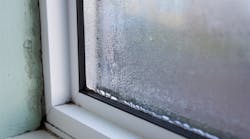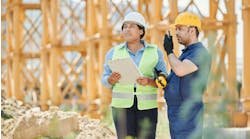Creating a comfortable environment for building tenants is paramount to the mission of a facility manager. And a large part of creating that comfortable environment stems from properly weatherproofing or weatherizing your building. Mitigating the outside air that enters your building can help prevent pollen and pollution from getting in—but it can also greatly lower your energy bills.
But identifying a problem area can be a challenge.
“Occupants generally aren’t complaining about the fact that their building is leaking air,” says Marcy Tyler, director of building science for Tremco Commercial Sealants & Waterproofing. “Usually, it’s identifiable once they start to see water damage. If you see water [damage], then you are leaking air in some way, whether it’s water getting in through an air gap or air bringing in water vapor, which is going to cause damage—which then, of course, affects your ability to heat or cool your building.”
Look out for moisture or condensation that might be gathering on windowpanes or other surfaces. Are window blinds moving when the wind blows, even if the window is closed? If you’re feeling uncontrolled air flow coming in, Tyler adds, whether hot air in the summer or cold air in the winter, that’s an indication that something’s not right.
Other strategies to know when it’s time to repair or improve your envelope for better weatherproofing include listening for signs of discomfort from occupants.
“Maybe a part of the building’s hotter or cooler, and you can’t control the comfort,” says Paul Springer, national director of AeroBarrier. “Or maybe someone with allergies has more problems in certain parts of the building. If you can’t regulate the temperature effectively, typically that means something is going on.”
Pay attention to odor and sound as well. Maybe your building comprises both office and industrial space, and if certain odors or even dust are generating in one part of the facility and making their way to the other, that could also be a red flag.
Tips for Success
1. Know your current state.
“I’ve heard an interesting comparison—that we all have to take our cars in to get their oil changed, right? Our cars tell us when it’s time, sometimes with a notification on your dashboard or it’s just not running properly,” Tyler explains. “Our buildings are the same way.”
What kind of condition are your doors, windows or exterior in? When were they initially installed? Are they still performing?
“A lot of times, doing a test on one window gives you an indication of what’s happening all over your building,” Tyler says. “We’ve talked to a lot of facility managers who are constantly chasing leaks all over the building. It depends on how much of a pain that has become before you might want to look into some sort of holistic approach.”
2. Don’t forget about your ductwork.
While replacing your doors and windows can be an efficient solution for a better weatherproofed building, it’s important not to overlook your ductwork. If air is leaking out of your ductwork, that means your HVAC system will need to work harder to create a comfortable environment and temperature for occupants.
“Duct sealing is the most efficient thing you can do for your building far and away, as far as return on investment and comfort,” Springer says. “The return you will get is quicker than any other thing you can do to that building.”
Springer says he’s seen FMs start by using their hands to feel around the ducts (that they can access) for rogue airflow and using thermal imaging to detect hot or cold spots.
“It’s definitely something that you can try to troubleshoot in a range of different ways,” he adds, “but it's the areas that you can’t access that are the bigger concern, unless you want to tear down walls and things like that.” That’s when a company like AeroBarrier could come in and help.
3. Be aware of other susceptible areas.
“If you’re doing a walkthrough,” Tyler says, “you’re going to want to look at where the horizontal meets the vertical everywhere, because that could potentially be an area of concern. How is it sloped? Is there a pooling of water occurring anywhere?”
Electrical outlets, pipe penetrations, any twist or turn or change in the plane, Tyler adds, are all susceptible areas.
What the Future Holds
Springer says that when it comes to weatherization, the commercial building code is a little behind the residential code. But it’s catching up.
“It’s something for FMs to think about,” he adds. “We’re starting to see different changes in the marketplace, specifically around the commercial building codes. It may not impact the existing structures, but for new construction, they're going to have to figure out ways to mitigate that or address that.
“Then you see across the country, states and cities are implementing carbon neutral plans and load reduction plans. Well, air sealing is one of the biggest ways to manage load reduction. As we move down this path of more requirements in new construction and cities asking buildings to do more in retrofit applications, air sealing and duct sealing are going to become more prevalent and more important.”
Read Next: Take These Top 4 Steps to Prep Your Building for Winter



